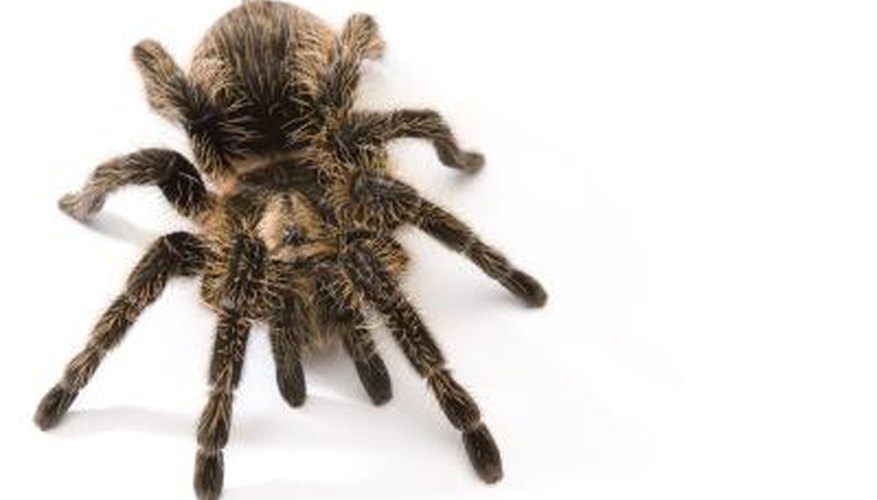For exotic pet owners, raising a baby tarantula can be a rewarding experience. While adult tarantulas are often portrayed as "big and scary," baby tarantulas are typically very small and fragile in early life. Many owners can be intimidated by the feeding process involved with baby tarantulas, or spiderlings, but it simply takes dedication. Always ask the provider of your spiderling for species-specific advice regarding feeding before attempting to feed your baby tarantula.
Water
Baby tarantulas are too small for water dishes, so pet owners should avoid putting a water dish in the tank with their spiderlings. Instead, baby tarantulas obtain the water they need from their prey and the humidity of their surroundings. However, you must regularly mist your spiderling's enclosure to keep it humid and moist. Avoid spraying your spider directly as spiders dislike this. Once your baby tarantula's legspan has grown to be equal to the diameter of a 2-liter soda bottle's lid, you can use the lid as a water dish. Always use clean, fresh water and avoid using damp sponges or paper towel as these can become bacteria breeding grounds.
- Baby tarantulas are too small for water dishes, so pet owners should avoid putting a water dish in the tank with their spiderlings.
- However, you must regularly mist your spiderling's enclosure to keep it humid and moist.
Food
When choosing what type of food to feed your baby tarantula, you must take its species into consideration. The most common prey for young tarantulas are small "pinhead" crickets or full-size, freshly killed crickets. While young tarantulas are able to kill "pinhead crickets," adult crickets must be killed or they may injure your pet. Maggots, baby cockroaches (especially smaller species) and termites can also be used to feed your spiderling. Some owners use fruit flies, but this may be difficult for aboreal tarantula species to catch so be wary of this if you choose to use them.
- When choosing what type of food to feed your baby tarantula, you must take its species into consideration.
- While young tarantulas are able to kill "pinhead crickets," adult crickets must be killed or they may injure your pet.
Feeding
As a general rule when feeding your tarantula crickets, the cricket's size should be no larger than the tarantula's body (excluding its legs). While small crickets may be given to your spider live, larger crickets must be freshly killed. Most owners do this by smashing in the cricket's head and cutting the cricket into smaller pieces, which make it more managable for your pet.
Feeding Schedule
Young tarantulas do not need to be fed daily. Regular feedings twice a week are the best regime for your growing pet. Any less than that and your spider may not be getting enough water, since it extracts water from its prey. Monitor your pet's eating habits and watch for any unusual signs. Keep in mind that spiders will refuse food if they are resting in preparation to moult. If you are concerned, you can continue offering your spider food until it eats, but remove any uneaten food from your spider's enclosure immediately the following day. Dead crickets can attract odours and pests.
- Young tarantulas do not need to be fed daily.
- Regular feedings twice a week are the best regime for your growing pet.
